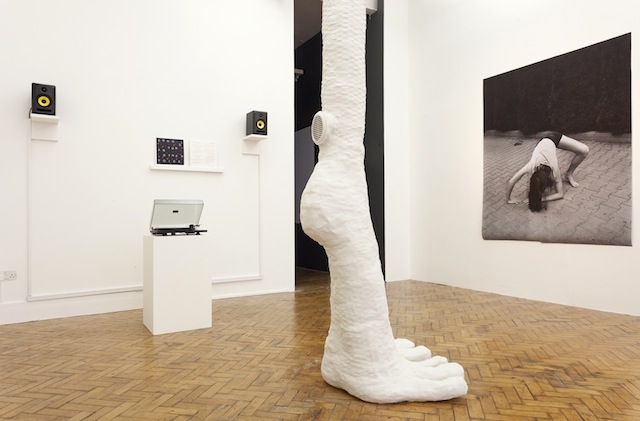Chapter, Cardiff, 18 March – 11 June
Word-heavy shows can tend towards the dry and worthy. Steering clear of such a possibility, this exhibition – curated by George Vasey and commissioned by Chapter to coincide with Cardiff’s annual arts festival Experimentica – dwells less on words than on their dissolution. Here, language spreads awkwardly, tackily, bodily; it is resistive, its meaning passing temperamentally from the intended to the received. A key critique, which Vasey’s excellent accompanying essay further unpicks, is the illusion of the apparent disposability of verbal language. Words seem to spread, unchecked and with abandon. Their implicit meaning percolates promiscuously through fast-paced media outlets, after which they appear to simply dissipate without consequence. Not so, this show convincingly argues.
The artists assembled here – Rebecca Ackroyd, Johann Arens, David Austen, Anna Barham, Marie-Michelle Deschamps, Foundation Press, Anneke Kampman, Joanna Piotrowska, Devlin Shea – are bound by a common interest in enacting and interrogating the volatility of language, albeit in various ways. First to greet you is Kampman, whose text score – as she calls it – is recorded and pressed onto vinyl. It is built up in stirring layers of spoken narrative that mount operatically, with a growing sense of foreboding. That’s if you choose to listen, of course; it’s up to you to put her record on.
The body as a silent but significant medium through which communication passes is a recurrent theme. Austen’s slight watercolours and Shea’s paintings of figures converse across one room; their subjects are pictured looking, holding and touching, enacting actions that speak volumes. Nearby, Ackroyd’s crude and preposterously large knobbly limbs – made from chicken wire, white plaster bandage and air vents – jut incongruously into the room; one of these, a lower leg, reaches floor to ceiling. And, from Arens’s On Haptics series (2015), hand shapes impress and partially protrude through darkened, glossy acrylic sheets reminiscent of primitive computer screens propped on office desks. They reach out but don’t get very far, meeting with little but resistance.
This gulf between words’ articulation – in print, in a mind, on a screen, in a mouth – and its reception is precarious, rife with misunderstanding and misrepresentation. Piotrowska’s photographed and filmed female figures mutely point, mime or twist themselves into bodily contortions, literally tying themselves in knots to make themselves understood.
Anything but neutral, such translations strain at the confines of bodies, language and media. Wallpapered to a largely hidden corner is one of the few text-heavy works of the exhibition. Barham’s Knives (2017) uses voice recognition software to render a passage by Vilém Flusser. Presented matter-of-factly, in small black type on white, closer inspection reveals a garbled transcription, flawed by technology’s relative crudeness. Stuttering, words appear in disconnected rows that don’t quite recur, their flow interrupted by blank spaces and excessive, insistent hyphenations. Nonsensical columns of repeated letter patterns emerge. It’s almost unreadable, like code. The text’s font size and unpredictable alignment add to the difficulty, as does the work’s placement: low down, taking in two corners of the gallery – which means that in order to follow it you have to move along its length.
Turning reading into a peculiarly estranging physical performance like this is just one of the challenges that These Rotten Words poses. By prodding, poking, pasting, printing, muting, enacting and singing, it assiduously attends to the undermining of spoken and written utterances. Its warning, if not new, is certainly timely: to cast words as straightforwardly explicative carriers of knowledge, feeling or information is not only disingenuous but deeply problematic.
From the May 2017 issue of ArtReview
